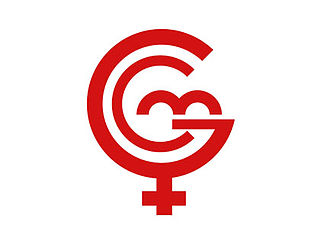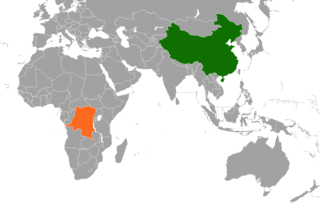
La Générale des Carrières et des Mines (Gécamines) is a Congolese commodity trading and mining company headquartered in Lubumbashi, in the Katanga region of the Democratic Republic of Congo. It is a state-controlled corporation founded in 1966 and a successor to the Union Minière du Haut-Katanga. Gecamines is engaged in the exploration, research, exploitation and production of mineral deposits including copper and cobalt.

The mining industry of the Democratic Republic of the Congo produces copper, diamonds, tantalum, tin, gold, and more than 63% of global cobalt production. Minerals and petroleum are central to the DRC's economy, making up more than 95% of the value of its exports.
Tenke Fungurume Mining SA (TFM) is one of the largest copper and cobalt producers in the Democratic Republic of Congo (DRC). Construction on the site began in the latter part of 2006, and in 2009, TFM produced its first copper. The mine has since become a vital source of income for local communities and the country by way of royalties and taxes, as well as the largest employer in the region.

The People's Republic of China (PRC) and the Democratic Republic of the Congo (DRC) have maintained diplomatic relations since 1961 and contacts between the two regions stretch back to 1887 when representatives of the Congo Free State established contacts with the court of the Qing dynasty. The first treaty between the two powers was signed in 1898.
Katanga Mining Ltd was a mining company operating in the Democratic Republic of the Congo with its headquarters in Canada. Katanga Mining operated a major mine complex in the Congo's Katanga Province, producing refined copper and cobalt. It claimed to have the "potential of becoming Africa's largest copper producer and the world's largest cobalt producer."
Kinsevere is an open pit mine and Heavy Media Separation plant with an electric arc furnace formerly operated by Anvil Mining, and now operated by Minerals and Metals Group. It is located 30 kilometres (19 mi) north of Lubumbashi, Katanga Province, Democratic Republic of Congo.
Copper mining in the Democratic Republic of the Congo mainly takes place in the Copper Belt of the southern Katanga Province of the Democratic Republic of the Congo.
The Kolwezi tailings project also known as the Roan Tailings Reclamation is a project in the Kolwezi mining area of the Democratic Republic of the Congo (DRC) to recover copper from the tailings, or processed ore, from mining in the region since the 1950s. The project was developed by the Canadian mining companies Adastra Minerals and then First Quantum Minerals between 2004 and 2009, when the DRC government revoked First Quantum's license. The project is currently majority owned by the Eurasian Resources Group.

Metorex is a mining company based in Johannesburg, South Africa. It has assets in the Democratic Republic of the Congo (DRC), Zambia and elsewhere. A takeover bid by the Jinchuan Group of China valued the company at US$1.1 billion. Since January 2012, the company is a wholly owned subsidiary of Jinchuan Group.
Tilwezembe is an open-pit copper and cobalt mine in Lualaba Province of the Democratic Republic of the Congo owned by Katanga Mining, a subsidiary of Glencore. Officially, Glencore has shuttered the mine, but the site is still being used by artisinal miners.
Mutoshi Mine is a copper mine in Katanga Province, Democratic Republic of the Congo. As of 2011 it was 70% owned by Anvil Mining and 30% by the state-owned Gécamines. The mine was placed on care and maintenance in late 2008.
The Etoile Mine is an open-pit copper mine on the outskirts of Lubumbashi in Katanga Province of the Democratic Republic of the Congo (DRC). Chemaf owns the license. Chemaf is 95% owned by Shalina Resources and 5% by the DRC government.
Mashamba East is an open pit copper mine near to Kolwezi in Katanga Province, Democratic Republic of the Congo. As of 2014, the mine was not currently not being actively worked.
The Kamoto Mine is an underground copper and cobalt mine to the west of Musonoi in the former Katanga Province, Democratic Republic of the Congo. As of 2022, the site is the largest active cobalt mine in the world. The mine includes the Luilu metallurgical plant, which accepts ore from KOV mine and Mashamba East mine. The plant has polluted the Luilu River, and tailings also pollute the region with wind-blown dust. The Kolwezi Tailings Project is an attempt to recover additional metal from these tailings.

The Luiswishi mine is an open cut copper and cobalt mine in Katanga Province of the Democratic Republic of the Congo (DRC).
Kalukundi Mine is a copper and cobalt mine being developed in Katanga Province, Democratic Republic of the Congo (DRC) by Africo Resources, a Canadian company. In September 2008 the company estimated the value of the resource as $1.47 billion.

The Central African Mining and Exploration Company plc (CAMEC) was a mining company active in the Katanga Province of the Democratic Republic of the Congo (DRC) and in other parts of Africa. It was acquired by Eurasian Natural Resources Corporation in 2009.
Dan Gertler is an Israeli billionaire businessman in natural resources and the founder and president of the DGI group of companies. He has diamond and copper mining interests in the Democratic Republic of the Congo (DRC), and has invested in iron ore, gold, cobalt, oil, agriculture, and banking. He may also hold citizenship of that country. As of 2022 his fortune was estimated at $1.2 billion by Forbes.
Nikanor plc was a publicly quoted holding company for Global Enterprises Corporate (GEC) with assets in the rich Copperbelt region in Katanga Province, Democratic Republic of the Congo (DRC).
The Mutanda Mine is an open-pit copper and cobalt mine in the Lualaba Province of the Democratic Republic of the Congo (DRC). It is the largest cobalt mine in the world. Accidents and spills at the mine have killed workers and polluted nearby rivers and fields. An NGO that has documented impacts of the mine concluded that spills have threatened community members' right to food.







